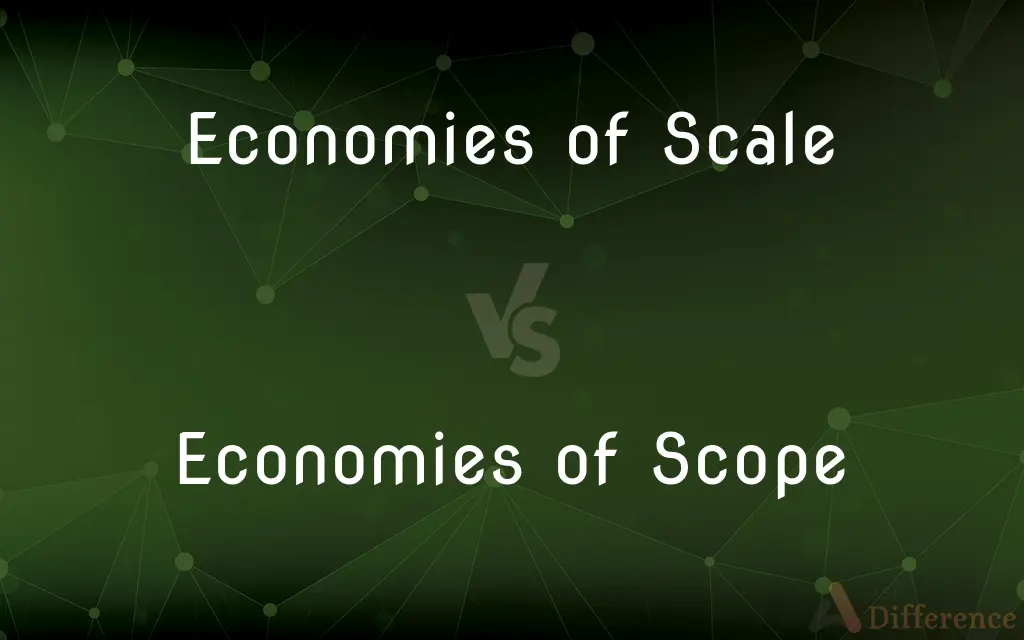Economies of Scale vs. Economies of Scope — What's the Difference?
By Tayyaba Rehman — Published on October 4, 2023
Economies of Scale refer to cost advantages due to increased output or scale of production, reducing cost per unit. Economies of Scope are cost benefits arising when producing a range of related products, leveraging shared inputs or processes.

Difference Between Economies of Scale and Economies of Scope
Table of Contents
ADVERTISEMENT
Key Differences
Economies of Scale refer to the cost advantages obtained by a firm due to the increase in the scale of production or output, ultimately leading to a reduction in the average cost per unit produced. Economies of Scope, on the other hand, refer to the cost benefits realized by producing a diverse range of related products or services, typically by utilizing shared inputs, processes, or technologies.
Economies of Scale primarily focus on the optimization of production processes and resource utilization to achieve lower per-unit costs as production volumes increase. Economies of Scope concentrate on the strategic diversification of production lines, optimizing shared resources across different products or services, to achieve overall cost efficiency.
While Economies of Scale are driven by the expansion and enhancement of a single product or service line, leading to a decline in the average production cost, Economies of Scope are propelled by the synergistic integration of varied product or service lines, leveraging commonalities and complementarities among them.
Economies of Scale usually benefit industries with high fixed costs and are particularly crucial for mass production, where increased output volumes contribute to reduced unit costs. In contrast, Economies of Scope are more advantageous in contexts where a range of products can be efficiently produced together, allowing firms to tap into new markets or customer segments by leveraging existing capabilities and resources.
In conclusion, while Economies of Scale and Economies of Scope both aim to achieve cost advantages, they differ in their approach and focus. Economies of Scale are about optimizing production to reduce per-unit cost through increased output, while Economies of Scope focus on diversifying product lines and leveraging shared resources to achieve cost efficiency across products.
ADVERTISEMENT
Comparison Chart
Focus
Increased output or scale of a single product or service.
Production of a diverse range of related products or services.
Cost Reduction Basis
Reduction in average cost per unit through increased production volumes.
Cost efficiency by leveraging shared inputs, processes, or technologies across varied products.
Beneficial Industries
High fixed cost, mass production industries.
Industries where a range of products can be efficiently produced together.
Approach
Expansion and enhancement of a single product or service line.
Synergistic integration and diversification of varied product or service lines.
Strategic Objective
Optimization of production processes and resource utilization for a single product line.
Strategic diversification and optimization of shared resources across different product lines.
Compare with Definitions
Economies of Scale
Economies of Scale occur when the increase in output leads to a proportionate reduction in the per-unit cost.
The automobile manufacturer benefited from economies of scale by standardizing parts across models.
Economies of Scope
Economies of Scope can lead to enhanced market reach and customer value through diversified offerings.
The fashion retailer exploited economies of scope, offering a wide range of apparel and accessories under one brand.
Economies of Scale
Economies of Scale are cost advantages achieved through increased production of a single product.
By doubling their production, the company realized significant economies of scale, reducing the cost per unit.
Economies of Scope
Economies of Scope are strategically significant for firms looking to diversify their product or service offerings.
By producing laptops and tablets, the tech firm realized economies of scope, utilizing shared technology platforms.
Economies of Scale
Economies of Scale can result from the efficient utilization of fixed costs and operational efficiencies.
The large factory allowed the firm to achieve economies of scale due to the high volume of goods produced.
Economies of Scope
Economies of Scope arise from the synergistic utilization of shared resources across varied products or services.
The company achieved economies of scope by cross-selling its range of financial products to existing clients.
Economies of Scale
Economies of Scale are essential for industries where mass production is viable and beneficial.
The steel industry often exploits economies of scale to optimize production and lower costs.
Economies of Scope
Economies of Scope refer to cost benefits achieved when producing a variety of related products.
The diversified manufacturer experienced economies of scope by using the same machinery for different products.
Economies of Scale
Economies of Scale ultimately lead to cost competitiveness and potentially lower prices for consumers.
Due to economies of scale, the tech company could offer its products at competitive prices, gaining market share.
Economies of Scope
Economies of Scope enable companies to optimize costs by leveraging common inputs and processes.
The food processing unit witnessed economies of scope by using shared ingredients across different snack items.
Common Curiosities
In which industries are Economies of Scale particularly crucial?
Economies of Scale are crucial in industries with high fixed costs and where mass production is viable, like manufacturing.
What are Economies of Scope?
Economies of Scope are cost benefits realized by producing a range of related products or services, utilizing shared inputs or processes.
How do Economies of Scope enhance cost efficiency?
Economies of Scope enhance cost efficiency by leveraging shared resources and synergies across diverse products or services.
Where are Economies of Scope more advantageous?
Economies of Scope are advantageous in industries where efficiently producing a range of related products together is possible.
Can Economies of Scale lead to lower prices for consumers?
Yes, Economies of Scale can lead to cost competitiveness and potentially lower prices for consumers.
How do Economies of Scale impact per-unit costs?
Economies of Scale lead to a reduction in average per-unit costs as the production volumes increase.
What is the strategic significance of Economies of Scale?
Economies of Scale have strategic significance in optimizing production processes and resource utilization for a single product line.
Why are Economies of Scope strategically important?
Economies of Scope are strategically important for firms aiming to diversify product lines and optimize shared resources across products.
How can a company realize Economies of Scope?
A company can realize Economies of Scope by synergistically utilizing shared resources and common inputs across varied products or services.
What is the impact of Economies of Scale on profitability?
Economies of Scale can enhance profitability by reducing average per-unit costs through increased production volumes.
How are Economies of Scale achieved?
Economies of Scale are achieved through efficient utilization of fixed costs, operational efficiencies, and increased output.
What do Economies of Scale refer to?
Economies of Scale refer to cost advantages achieved through increased production of a single product, reducing per-unit costs.
How do Economies of Scope impact market reach?
Economies of Scope can enhance market reach by allowing firms to offer a diversified range of products or services.
Can Economies of Scale and Economies of Scope coexist in a company?
Yes, a company can simultaneously achieve Economies of Scale and Economies of Scope by optimizing production and diversifying products.
How do Economies of Scope affect a company's competitiveness?
Economies of Scope can enhance a company's competitiveness by allowing cost-efficient production and diversified offerings, catering to varied consumer needs.
Share Your Discovery

Previous Comparison
Audit Services vs. Non-Audit Services
Next Comparison
Hue vs. SaturationAuthor Spotlight
Written by
Tayyaba RehmanTayyaba Rehman is a distinguished writer, currently serving as a primary contributor to askdifference.com. As a researcher in semantics and etymology, Tayyaba's passion for the complexity of languages and their distinctions has found a perfect home on the platform. Tayyaba delves into the intricacies of language, distinguishing between commonly confused words and phrases, thereby providing clarity for readers worldwide.
















































